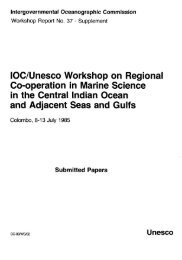Manual on sea level measurement and ... - unesdoc - Unesco
Manual on sea level measurement and ... - unesdoc - Unesco
Manual on sea level measurement and ... - unesdoc - Unesco
- No tags were found...
Create successful ePaper yourself
Turn your PDF publications into a flip-book with our unique Google optimized e-Paper software.
Sea Level Measurement <strong>and</strong> Interpretati<strong>on</strong>gravity <strong>and</strong> GPS are both approaching the equivalentaccuracy of 1 cm that is required for measuring verticalcrustal movements.Absolute gravity <strong>measurement</strong>s are normally made in ac<strong>on</strong>venient building that provides reas<strong>on</strong>able temperaturec<strong>on</strong>trol. This site then needs to be c<strong>on</strong>nected to theTGBM <strong>and</strong> the local benchmarks using high precisi<strong>on</strong><strong>level</strong>ling. Correcti<strong>on</strong>s for ocean tide loading <strong>and</strong> attracti<strong>on</strong>are particularly important at or near coastal sites, asis the additi<strong>on</strong>al ocean tide attracti<strong>on</strong> due to the elevati<strong>on</strong>of the site.Owing to the higher cost of absolute gravimeters comparedto GPS receivers, the number of tide gauges beingm<strong>on</strong>itored is likely to be a small sub-set of the tide gaugeswith GPS. It has been recommended that the <strong>measurement</strong>sof absolute gravity should be c<strong>on</strong>centrated at keytide gauges in the GLOSS-LTT network, where they willbe most useful in c<strong>on</strong>tributing to meeting the challengeof determining vertical crustal movements to an accuracyof better than 1 mm per year. Absolute gravity <strong>measurement</strong>sat the GLOSS tide gauges at Newlyn <strong>and</strong> Lerwickhave recently shown that there are systematic errors inCGPS, which lead to errors in the vertical rates determinedfrom GPS (Teferle et al., 2006). This shows the importanceof independent techniques for identifying systematicerrors <strong>and</strong> the reducti<strong>on</strong> of these errors is currently animportant topic of re<strong>sea</strong>rch in the GPS community.4.4.5 Geocentric Co-ordinates <strong>and</strong> Vertical L<strong>and</strong>Movements of Tide Gauge BenchmarksFrom 2001 to the end of 2005, the Internati<strong>on</strong>al GNSSService (IGS) set up a pilot project called TIGA, whichis processing <strong>and</strong> analysing CGPS data from over 100tide gauges around the world in a c<strong>on</strong>sistent globalreference frame. The web site (http://adsc.gfz-potsdam.de/tiga/index_TIGA.html) should be c<strong>on</strong>sulted for informati<strong>on</strong>about the stati<strong>on</strong>s <strong>and</strong> the results that are beingobtained. The GPS global <strong>sea</strong> <strong>level</strong> m<strong>on</strong>itoring networkwill be a fully integrated comp<strong>on</strong>ent of the Internati<strong>on</strong>alGNSS Service – Internati<strong>on</strong>al Earth Rotati<strong>on</strong> Service (IGS/IERS) Internati<strong>on</strong>al Terrestrial Reference Frame (ITRF). Theproducts from this network are the co-ordinates <strong>and</strong>velocities of the benchmarks at tide gauge stati<strong>on</strong>s. ThePermanent Service for Mean Sea Level (PSMSL) archivingsystem has been designed to bank the vertical crustalvelocities derived from selected IGS soluti<strong>on</strong>s, al<strong>on</strong>g withexplanatory informati<strong>on</strong>, including the names of expertswho can be c<strong>on</strong>tacted by users of the system.34IOC <str<strong>on</strong>g>Manual</str<strong>on</strong>g>s <strong>and</strong> Guides No 14 vol IVFigure 4.4 Schematic of an absolute gravimeter.
















